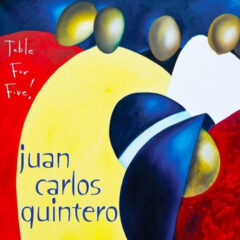CD Reviews
JUAN CARLOS QUINTERO: Table for Five!
Jazz guitarist Juan Carlos Quintero has released nearly a dozen albums since 1990. Table For Five! is his latest effort, featuring a solid quartet along for the ride, including Eddie Resto, bass; Joe Rotondi, piano; Aaron Serfaty, drums; and Joey DeLeon, percussion. Recorded and mixed deftly by Talley Sherwood at Tritone Studios in Glendale, California, the ten-track disc showcases Quintero and the guys riffing effortlessly through eight Real Book standards, along with two Quintero originals.
The overall personality of the album is clearly identified in the opening track “Alone Together,” set over a fiery Latin rhythm, concluding with a frenetic cumbia groove. Percussionist DeLeon makes his presence known amid the catchy mambo groove on “Mambo Balahu,” followed by the two minor key Luiz Bonfa standards, “The Gentle Rain,” where Quintero executes flawless double-time lines reminiscent of George Benson’s version in his CTI recording days and “Manha De Carnaval,” eloquently played against a slow tempo tango rhythm.
A Quintero original, “Table for Five…at the Cumbia Inn,” is a nicely crafted playful sequence of eight-bar verses and choruses ornamented by Quintero’s staccato and pizzicato treatments as well as DeLeon’s strong percussion presence once again. “Song for my Father” spotlights Rotondi masterfully tickling the ivories over the Horace Silver classic segued by Quintero’s smooth electrified fusion lines.
The second Quintero original, “Porque Si Quieres,” features another side of his playing with nifty double-stop and chord melody voicings against a lively cumbia rhythm with Serfaty and DeLeon finishing with a barrage of percussion interchanges. Quintero chooses an up-tempo treatment of “Days of Wine and Roses,” bringing Resto out of the shadows for a 32-bar solo spotlight on stringed bass, followed by Quintero and Rotondi trading burning, bebop-laced solos to its close.
Not many guitarists dare attempt to play John Coltrane’s tune “Giant Steps,” but Quintero breezes through the challenging chord pattern with flying colors, leaving no doubt about his eclectic guitar prowess. The album concludes with a tender rendition of the 1930s balla, “Beautiful Love,” offering Quintero a final moment to strut his stuff by melodically weaving through the chord changes in clean double-time fashion like many of the bebop guitar masters of the past, putting a nice punctuation mark to this veteran quintet’s high level of musicianship and interplay.






